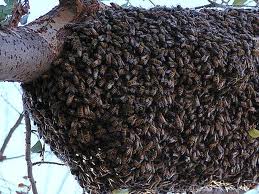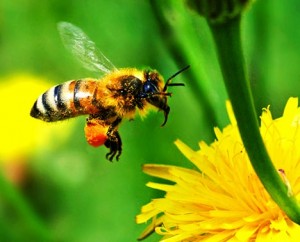 The Africanised honey bee or ‘Killer bee’ is widely feared by the public, a reaction that has been encouraged by sensationalist movies and exaggerated media reports. Although this bee is much more aggressive than a European honey bee, stings from Africanised bees kill only 1-2 people per year in the United States which is a similar figure to that of wasps and European honey bees.
The Africanised honey bee or ‘Killer bee’ is widely feared by the public, a reaction that has been encouraged by sensationalist movies and exaggerated media reports. Although this bee is much more aggressive than a European honey bee, stings from Africanised bees kill only 1-2 people per year in the United States which is a similar figure to that of wasps and European honey bees.
Killer bees are a hybrid of African and European honey bee species and were accidentally introduced into the ecosystem from a laboratory in Brazil in 1956, where scientists were attempting to create a strain of bee with improved honey production.
The Africanised queens and consequently the colonies escaped, swarmed and began to quickly establish themselves throughout South and Central America. The first sign of Africanised bees in the United States was in October 1990, in Southern Texas. The bee then spread steadily across the southern part of the United States where the winters are mild and the summers are very warm. However scientists and entomologists believe that the Africanised bees are now adapting to colder climates and roaming further north at an average rate of 2 miles per day. If this projection is true, it could become a major problem to the European honey bee within the United States and possibly eventually even Europe.
How to Identify a Killer Bee.
People are often surprised to learn that killer bees are in fact slightly smaller in size than European bees. They are however virtually indistinguishable from each other when viewed with the naked eye and precise identification can only be done microscopically.
The Africanised bee will become agitated as a result of a perceived threat ten times quicker than a European bee. The latter will stay closer to their hive to defend it if they feel threatened and most of the colony will stay inside and start working to remove their honey stores, leaving just a few guard bees to see off the threat. However Africanised bees will leave their hive en masse’ to defend it, surrounding the perpetrator and inflicting as many stings as possible and are also likely to give chase for up to a quarter of a mile. It is this behaviour pattern that has led to them being called ‘Killer bees’. One of the main reasons why they behave in such an aggressive collective manner is that unlike the European honey bee their main focus is not on their honey stores, but on multiplying their numbers. This is because they are originally adapted to live in warm climates where winter hibernation is not necessary and therefore the need for large honey stores does not arise. For this reason they collect much more pollen (necessary for growth in young) and as a result are in fact better pollinators.
Nesting
European honey bees rarely build nests on the ground or in exposed locations, whereas Africanised bees will build a nest anywhere they can find a hole large enough to fit through and their nests are much smaller. If they cannot find a suitable concealed location they will nest in the ground or in tree branches. The Africanised bees will often invade a European bee colony replacing its queen with one of their own.
Swarming
European honey bees swarm once or twice a year, whereas the Africanised honey bees swarms ten times or more a year allowing them to colonize much larger areas. Furthermore, the Africanised bees will completely abandon or ‘abscond!’ from their nests whenever environmental factors become unfavourable, whereas European honey bees rarely ever abandon a nest completely.
The Future
Africanised bees are effectively a work in progress as they continue to breed with European bees. Scientists and beekeepers however are now using selective breeding programmes to try to control and manage the problem. In particular it is recognised that the African bee has a lot of positive traits, for example it is more disease and pest resistant than the European bee and is a more active forager. Therefore by selecting these traits in addition to trying to breed out its aggressive ones, the end result may be more favourable than was once feared.
By Maggie Roberts
To learn more about Beekeeping see http://www.beekeepingbeesandhoney.com/

